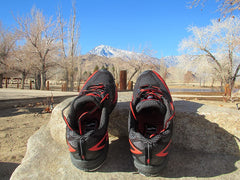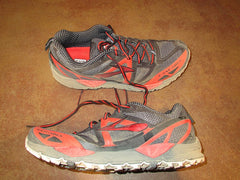Free shipping on US orders $120 and up (restrictions apply)
Free shipping on US orders $120 and up (restrictions apply)
Climbing Gym
Rentals
Gear Shop
Mountain Resources

Brooks Cascadia 9 Review
January 23, 2014 4 min read
I have been a dedicated Cascadia convert since whatever edition was around in 2008, when Sage to Summit’s Brooks rep handed me a pair and said something to the effect of, “Give these babies a try. I think you’ll like ‘em.” He was wrong. I didn’t like them…I loved them. My love of the Cascadias seemed to grow stronger with each year’s new version; then, the Cascadia 8 came out last year and the feet of my heart began to wander. The 8 was still a solid shoe, but, at least for me, the fit was just “off,” the cushion wasn’t all there and the ride wasn’t as smooth. I found myself checking out other shoes, wearing out other shoes even. My relationship with the Cascadias seemed to be on the rocks and I could barely stand the thought of jumping feet first into the “go-to” running shoe dating pool again. Fortunately, after 3 days and 65+ miles of varied terrain in the 9th and latest edition I can confidently say to the Cascadia that, once again, I am emotionally yours.

If that sounded melodramatic, well, maybe, but the reality is that every runner wants, heck needs, to have a “go-to” shoe they can rely on without question or doubt. My quiver of shoes is broad and diverse, and many of them I really enjoy logging miles in, but none quite as much as the Cascadia. Why? Read on…
First off, for those that loved the Cascadia 7, but loved the Cascadia 8 not-so-much, the Cascadia 9 feels very much like a throwback to the 7. It is well-cushioned, has a very smooth ride, and the fit is more in tune with previous models (The 8 for many was a bit long in their normal size and considerably more voluminous, making dialing in the size an issue. Also, for some the 8 felt “flat” and lacking in the super-smooth ride the Cascadia is known for.). If anything the Cascadia 9 went a bit too narrow in the forefoot. In the area of the forefoot pivot posts I developed irritated spots on the lateral sides of my feet that eventually developed into small blisters. Of course, this occurred during back-to-back out of the box long runs of 25 & 24 miles in unusually dry and warm “winter” conditions. Two days later, with a minor loosening of the laces and a slightly thinner sock, I went out for a 17 miler with a healthy dose of vert and had no further issues. So, for what it’s worth, just be aware that the fit is on the narrow side. For me, it has done nothing to diminish my excitement about the shoe.
My excitability about this shoe stems from its comfort, ride and versatility. With its bomber-grippy, aggressively-lugged outsole, forefoot rockplate, protective toecap and neutral-yet-stable platform the Cascadia 9 is meant for the steepest, most rugged trails and cross country, peak bagging terrain you can find, but because it is so well-cushioned and has such a smooth heel-to-toe transition the 9 feels equally at home on groomed dirt roads and trails, and even asphalt, making it a hybrid shoe of sorts although it isn’t marketed as such. On the aforementioned 17 miler the Cascadia 9 felt equally awesome when I was grinding out 16 minute miles on a super-steep ascent, tap-dancing back down the rocky singletrack and opening it up at the end on rolling dirt roads with some sub-7s.
In wet conditions the mesh upper drains well, and when it really gets sloppy and muddy, the snow begins to fly, or you find yourself crossing a slippery, lingering snowfield during a Sierra summer run the outsole traction will keep you upright and confident. The upper on the 9 continues the trend of mostly welded overlays and this upper seems to be a bit more reinforced on the lateral and medial sides enhancing the structural integrity and dishing up a more snug, stable glove-like fit.
Despite the fact that the Cascadia is a neutral shoe with a more traditional heel-to-toe drop (I have heard that it is slightly lower, probably in the 8-10mm range, in the 9th version compared with previous ones, but I couldn’t find info on the exact numbers.) it somehow delivers a low profile feel and it is rock solid stable, thanks in part to the 4-point pivot post system that mimics a vehicle’s suspension. When I plan on hammering down a technical and/or steep trail, this is the shoe I want on my feet for maximum confidence.
The Cascadia 9 is not particularly light by today’s trail shoe standards, weighing in at just under 12oz, but light is not always right or better, and this shoe simply never feels like too much of a good thing.
If I had to sum up the Cascadia 9 in one sentence it would be this: if I could only have a quiver of one for 2014, as of now, this would be the shoe. It feels good to be able to say that again about the Cascadia. But I won’t go so far as to buy it flowers. I’ll save the flora for my girlfriend and take the Cascadia 9s out on a multi-day running and hiking trip in the Sierra this summer. Oh, did I not mention that these make excellent fastpacking shoes? Because they do. Versatility, remember?

Features:
- 11.7oz (mens)/9.7oz (womens)
- Slightly lower heel than previous Cascadias
- Forefoot rock shield
- Heel & forefoot pivot posting system
- Seamless upper with welded overlays
- Aggressively-lugged, grippy, outsole
Please comment on the post if you have any questions about the Cascadia 9, or feel free to email me directly at jeff@sagetosummit.com.
https://www.youtube.com/watch?list=UUbM_tsL41_L8d2t3qH3ccLA&v=TJk45LOndFE
Leave a comment
Comments will be approved before showing up.
Subscribe
Sign up to get the latest on sales, new releases and more …





